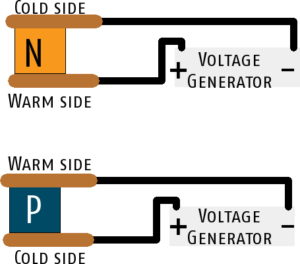
Peltier cells
PELTIER EFFECT
When a direct current crosses the contact surface between two different conductors, one of these absorbs heat (cold side) and the other generates heat.
Positive or negative Peltier coefficient
For a given material, the direction of the current defines the cold side and the warm side.
Different materials have different Peltier coefficients (for calculating the heat transferred by a joint).
Some have a positive coefficient and others negative (i.e. they reverse the cold side with respect to the hot side).
The Peltier effect is more evident in semiconductors, the P doped ones have a positive coefficient, the N doped ones have a negative coefficient.
Structure of a Peltier cell
To perform the heat transfer, each junction draws a few mV but also several amps of current.
The solution adopted is to connect N-type and P-type semiconductors in series, through a copper plate.
By applying positive voltage to the N cell and negative to the P cell, the upper side cools and the lower side heats, thus reversing the voltage also reverses the direction of heat transfer.
A normal Peltier cell contains several hundred series connected junctions.
Uses
Typical fields of application are: conservation of biological samples, cooling of optical sensors, lasers, electronics, but also small portable car refrigerators, mini cold water dispensers, temperature control of electrical panels.
Peltier cell controller
Ascon Tecnologic has developed a special PID controller (TLK33) for the control of Peltier cells which is able to modulate and invert the output voltage allowing to control both the power and the operating direction of a Peltier cell.
Our products for this application
- Display 15 Products per page


